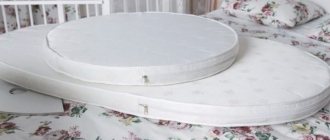Healthy sleep is necessary for the full functioning of the human body. It has a positive effect on well-being, mood, and gives strength, energy and good spirits for the whole day. But not every dream can be called healthy. And this is often due to an uncomfortable sleeping bed. Therefore, if you really want to relax, you need to approach its arrangement wisely.
It is necessary to exclude all the nuances that may interfere with a good rest - an uncomfortable bed, poor-quality bed linen. But the most important thing is to choose the right mattress. Its characteristics should suit your needs. It is necessary to take into account the design features of the product, workmanship, degree of rigidity, and most importantly, the size of the mattresses. To understand which one is right for you, we suggest you get acquainted with the variety of dimensions of these products.
Standard mattress sizes
Dimensions are one of the most significant characteristics of a mattress for the buyer. They must correspond to the parameters of the furniture for which the product is purchased. This information can be gleaned from the technical data sheet that the manufacturers supplied with the sleeping bed. If there is no such document, use a tape measure and use it to measure the length and width of the bed frame from the inside.
First of all, let's decide on the length. The most common bed length can be considered typical – 200 cm. A bed of this size will suit almost any person. It can be reduced if a short person experiences discomfort during sleep.
The length of the bed must be at least 15 cm greater than the person’s height.
The width depends on the type of bed. Depending on it, all mattresses can be divided into three key groups:
- single;
- one and a half sleepers;
- double.
For double bed
If the width of the mattress exceeds 140 cm, it falls into the double category. A bed with dimensions of 140x190, 140x200, 150x200, 160x200, 180x200 cm is considered an acceptable option for a married couple. But placing two people on a mattress with a width of 140 cm is not very comfortable. After all, each of the sleeping people ends up with only 70 cm. And if the spouses do not have an asthenic physique, they obviously will not have enough such space.
A mattress with dimensions 140x200 is optimal if:
- there is a shortage of free space to accommodate a full-fledged sleeping place;
- the parent is forced to sleep with the child due to the latter’s medical conditions - due to a mental state disorder - the occurrence of fears, panic attacks.
The most commonly used mattresses are widths of 160, 180 and 200 cm. If the width is equal to or exceeds 2 m, then the length starts from 200 cm - 200x240, 220x220, 200x240, 220x240. These sizes are not standard, but they can be made to order.
For a single bed
If you don’t need a double bed, but for some reason the width of a single bed is not enough for you, consider a one-and-a-half-size option. The line of such mattresses includes products with dimensions - 100x200, 110x190, 120x190, 120x200, 130x190, 130x200 cm. Such a bed will not restrict your movements and will allow you to sit comfortably while sleeping. Therefore, if there is the possibility of installing such a model in the bedroom, consider it in more detail. A bed like this can accommodate two people, but this will reduce the degree of comfort. If you decide to use a single bed with a partner, we recommend giving preference to options with a width of 130.
For single bed
Single mattresses can only be used alone. The dimensions of these models are as follows - the width can range from 80 to 90 cm, and the length from 180 to 200. Manufacturers offer the following options for standard sizes of single mattresses - 80x180, 80x190, 80x200, 90x190, 90x200 cm.
If the product is purchased for a child, you can choose a model with a length of up to 170 - 175 cm. However, you need to keep in mind that closer to adolescence the bed will have to be changed. For a teenager, the most comfortable option would be a bed with a size of 80x190 cm. This is the most profitable option in terms of money, since it will not need to be changed as your child gets older and grows. A bed with such a mattress can be placed in any small apartment without any problems. That is why models with such parameters are installed in hotels and hostels.
More details about the sizes of standard models can be found in the table.
Table of standard mattress sizes
The generally accepted length of a mattress is 200 cm. This size is universal and suitable for almost every adult. The length of the mattress should be greater than a person’s height, but not exceed 15 cm.
The width of the products differs as there are single and double mattresses. There is also an intermediate option - a single bed.
Mattresses come in rectangular and round shapes, the size of which is determined by diameter. Round mattresses are also divided into:
- 1-single, diameter varies from 200 to 210 cm.
- 1.5 bedrooms - 220 cm.
- 2-bedrooms - from 230 to 240 cm.
Single mattress sizes
| 80 cm | 85 cm | 90 cm | 95 cm |
| 80 to 190 | 85 by 190 | 90 to 190 | 95 by 190 |
| 80 to 195 | 85 by 195 | 90 to 195 | 95 by 195 |
| 80 to 200 | 85 to 200 | 90 to 200 | 95 to 200 |
Sizes of one-and-a-half mattresses
| 100 cm | 110 cm | 115 cm | 120 cm | 125 cm | 130 cm | 135 cm |
| 100×190 | 110×190 | 115×190 | 120×190 | 125×190 | 130×190 | 135×190 |
| 100×195 | 110×195 | 115×195 | 120×195 | 125×195 | 130×195 | 135×195 |
| 100×200 | 110×200 | 115×200 | 120×200 | 125×200 | 130×200 | 135×200 |
Double mattress sizes
| 140 cm | 145 cm | 150 cm | 155 cm | 160 cm | 165 cm | 170 cm | 180 cm | 200 cm |
| 140×190 | 145×190 | 150×190 | 155×190 | 160×190 | 165×190 | 170×190 | 180×190 | 200×190 |
| 140×195 | 145×195 | 150×195 | 155×195 | 160×195 | 165×195 | 170×195 | 180×195 | 200×195 |
| 140×200 | 145×200 | 150×200 | 155×200 | 160×200 | 165×200 | 170×200 | 180×200 | 200×200 |
| 160×205 | 180×205 | |||||||
| 160×210 | 180×210 |
Round mattress sizes
| Diameter in cm |
| 200 |
| 210 |
| 220 |
| 230 |
| 240 |
Children's mattress size chart
| For children - 60 cm | For children - 65 cm | For children - 70 cm | For children - 75 cm | For children - 80 cm |
| 60×120 | 65×125 | 70×140 | 75×190 | 80×160 |
| 60×190 | 65×190 | 70×160 | 75×200 | |
| 60×195 | 65×195 | 70×190 | ||
| 60×200 | 65×200 | 70×195 | ||
| 70×200 |
Mattresses for children can also be selected according to thickness. Standard sizes vary from 6 to 12-13 cm. Spring mattresses have a thickness of 16 to 18 cm.
Euro mattress sizes
European models are slightly different in size from domestic ones and are indicated in mm. The size range has a step of 10 cm. We invite you to familiarize yourself with the standard sizes of a sleeping place adopted in European countries.
- single beds have parameters - 80x180, 80x190, 80x200, 90x190, 90x200 cm;
- double - 1400x2000, 1600x2000, 1800x2000, 1900x2000, 2000x2000 mm.
The concept of a single-size mattress does not exist in the European system.
Mattress width
All models can be divided into 3 classes: single, single and double.
- On single beds
(80x190, 80x200, 90x190, 90x200 cm) and
single beds
(120x190, 120x200 cm) only one person can comfortably lie. Of course, you can fit two people in a one-and-a-half-bed room, but it will be a bit cramped. Which option should I choose for one? If you like more spacious beds, and the size of the bedroom allows you to place a large bed, take the one-and-a-half-size option; - On double beds
(140x190/200, 160x190/200, 180x190/200, 200x190/200 cm) it will be comfortable for both spouses. The minimum width is 140 cm, the optimal width is 160 cm. Widths of 180 and 200 cm are already family size beds, an excellent option for couples with small children.
Sizes of mattresses for newborns
Mattresses for the smallest – for newborns – also have certain standards. The most common size is 60x120 cm or 70x140 cm. Such models are easy to find, since they are presented in the lines of all manufacturers of this range.
But some of them went further and developed a more variable size range with parameters from 60 - 80 to 120-160.
The thickness of children's mattresses for newborns is small - as a rule, they are thin. The height ranges from 6-13 cm. If the product is equipped with a spring block, its thickness can reach 16-18 cm. When choosing a product, it is necessary to take into account that crib manufacturers recommend mattresses of a specific height for use.
Standard sizes of mattresses for children and adults
Mattresses for adults
For all rectangular mattresses, the standard length can be 190, 195 or 200 centimeters. But they differ in width:
| Number of beds and design | Standard sizes |
| Single mattresses | 80 x 190 cm; 80 x 195 cm; 80 x 200 cm. |
| Single mattresses | 120 x 190 cm; 120 x 195 cm; 120 x 200 cm. |
| Double mattresses | 140 x 190 cm; 140 x 195 cm; 140 x 200 cm; 160 x 190 cm; 160 x 195 cm; 160 x 200 cm; 180 x 190 cm; 180 x 195 cm; 180 x 200 cm; 190-200 x 190 cm; 190-200 x 195 cm; 190-200 x 200 cm. |
| Non-standard mattresses are called round bed frames. However, for them there are certain diameter standards: | |
| Round mattresses | Small mattresses are products with a diameter of Ø 200 cm; Medium mattresses have a diameter of Ø 220 cm; Mattresses with a diameter of Ø 230 cm are considered large. |
Children's mattresses
And newly born babies also have mattresses in their cribs that are made to certain standards. Most often they are 120 centimeters long and 60 centimeters wide. If the crib is intended for an older child, then it needs a larger mattress - 70/140 centimeters.
It should be noted that today manufacturers can pamper us with a variety of sizes of children's mattresses. Their width ranges from 60 to 80 centimeters, and their length ranges from 120 to 160 centimeters.
Now it’s worth talking about the thickness, which for a mattress without springs can range from 6 centimeters to 12 - 13 centimeters. If the mattress has springs, then it may well be 16 - 18 centimeters high. By the way, sometimes this characteristic is of paramount importance - after all, some models of cribs must be equipped with a mattress of a specific thickness. In such cases, this is indicated in the product passport.
Sizes of children's and teenagers' mattresses
The most popular option for children is 60x120 cm. But when purchasing, the same rule applies as for adults - the length of the product must be at least 15 cm greater than the height of the child sleeping in it. Accordingly, you can choose the following sizes - 65x125, 70x140 cm.
If the baby is already 3 years old, it is better to immediately choose a larger option, since the child is constantly growing, and a small crib can very quickly become cramped for him. The hierarchy of standard sizes in this case is as follows - 60x120, 70x150, 70x160, 80x160 cm.
It is also better for a teenager to purchase a sleeping surface “for growth.” Thanks to this, you can eliminate unnecessary material costs in the future. The standard dimensions offered by manufacturers for teenagers are 60x170, 80x180, 70x190 cm. But it is better to purchase a one-and-a-half bed, which will provide comfortable rest even for a large child. The thickness of the product - from 6 to 12 cm - does not always contribute to proper rest, especially if the child’s weight is almost the same as that of an adult. It is best to choose products that do not have springs and have hard filling inside.
Children's mattresses
The standard and most common size of a children's mattress is 60x120 cm. There are other options, for example, 70x140, 80x160 cm and so on.
You need to choose according to the child’s height, so that the mattress is at least 15 cm “higher” or take a mattress “for growth.” And, of course, the mattress should always fit the size of the existing crib.
Children's mattresses are thinner than adults - from 6 to 12 cm. Remember: for children it is recommended to choose springless models with hard filling, for example: Promtex-Orient Biba Bikombi Hard.
Round mattress sizes
If you want to create an interesting design or a romantic setting, you can use round models. They have only one parameter that determines their size - diameter. Let's consider the dimensions of round mattresses depending on the number of beds and usable area for a good night's sleep.
- up to 200 mm - with such dimensions, mattresses correspond to the size of beds for children or teenagers;
- single beds – have a diameter from 200 to 230 cm – a standard bed with one sleeping place;
- double – from 240 cm – an alternative to a double bed with a width of 180 cm.
Standard mattress sizes for double beds
No matter how high-quality and expensive the mattress is, if you make a mistake by five centimeters, it will entail a lot of inconvenience. In order to guess the size, measure your bed before going to the store to know exactly what size mattress you need.
Lenght and width
Parameters of double mattresses, standard:
- The width is: 140, 160, 180 and 200 cm;
- Length: 190, 195 or 200 cm, as well as an extended version up to 220;
Height
- The height for springless mattresses is from 5 to 25 centimeters, with springs from 20 to 55 centimeters.
Size Chart (in cm)
| Width | Length | |
| Russian | 140-200 | 190-200 |
| Euro | 140-180 | 200-220 |
| King-size (American) | 200 | 200-220 |
The universal length is considered to be 200 centimeters. It is definitely suitable for people above average height. If your height is no more than 175 centimeters, then feel free to order a length of 190 cm. If you like space, then you should consider king-size models.
When choosing, adhere to the following rule: Mattress length = person’s height + 15 centimeters.
↑ All commercially available sizes of double mattresses
There is also a mattress option for a round bed, in which case only one parameter is important - the diameter. Typically, such mattresses are 230-240 cm in circumference.{banner_serefs}
Measures for determining the size of a sleeping place
Before you go to the store to buy a mattress, it would be useful to obtain information about the variety of existing measurement systems.
- Metric . This system has been accepted for use in Russia and some European countries - Italy, France, Germany. Standard units of measurement are used - meters and sentiments. The mattress widths are available in 5 or 10 cm increments.
- English . Measurements are taken in feet or inches. This system is common in English-speaking countries - Great Britain, USA, Australia. With a mattress length of 80 inches and a width of 78 inches, the equivalent in the metric system would be 203.1 and 198.1 cm, respectively. Translating values from one system to another often leads to errors in selecting a European or Russian mattress for an English bed or vice versa. The names of the standards also do not match. Thus, the size of a European semi - 1600x2000 is considered in America to be a double, and also the most common and cost-effective option.
Compliance with dimensions is a very important parameter when choosing a mattress - the standard size of an English double bed is 1400x1900 mm, and a European one will have a width and length of 1800 and 2000 mm, respectively. The American single bed called extralong is three cm larger than its European counterpart - 1900x800, 1900x900 mm.
The easiest way to avoid a mismatch between the size of the mattress and the dimensions of the bed is to choose products from the same brand or at least from one country. Alternatively, you can order products in a custom size.
Standard sizes
According to GOST standards, mattresses have the following dimensions:
Mattresses for newborns
For babies, there are mattresses with their own standard sizes, usually models 100-120 centimeters long and 50-60 cm wide. For older babies, you can find a slightly larger model, 70/140.
It is important to consider its height when choosing a product. It can have from 6 cm to 12 cm, with springs up to 18 cm.
There are crib models that require a certain model size.
Children's mattresses
When wondering what sizes of children's mattresses are available, it is worth checking for what age. Please note that for a child, teenager, as well as for an adult, the sleeping place should be 15 cm longer than the height for whom it is intended. For an older child, it is worth considering an adult model, so that in a couple of years you do not have to go back to purchasing a new bed and mattress.
For teenagers, single and one-and-a-half models are selected. These parameters are suitable for a child of any weight; the bed will fit harmoniously into any room, even a small one.
For children's bunk beds, the side of the structure should be 15 cm higher than the mattress; this is necessary for the child's safe sleep, especially if he tosses and turns a lot in his sleep.
Mattresses for adults
When choosing a model for an adult, before purchasing, you should understand what types they are divided into and what sizes of the mattress are available.
Single
The product is designed for one person. The standard size of a single mattress is 80-90 cm wide, 180-200 cm long. Such models are usually used in hotels. Suitable for growing teenagers. If a married couple likes different firmness, you can combine two single beds, made from different fillings, and combine them with a mattress topper.
One and a half
I am not satisfied with the first option in terms of parameters; a one-and-a-half-piece product would be a good alternative. The standard parameters of a one-and-a-half product are width 100-130 cm, length 190-200 cm.
Double
This model can accommodate two people, but it will not be very comfortable; a more suitable option is 130 cm wide.
Models with a width of 140 - 160 cm are called double, 190-200 cm long, it can accommodate two.
Product 140x200 is suitable:
- for slender spouses;
- for parent and child;
- for a man of impressive size.
The most common size is 160x200 cm. Products with wider parameters 180x200, 200x200 are a good choice for a family with a small child, or if a pet prefers to sleep with the owners. There is enough space for everyone on this sleeping bed.
Euro
In European countries there are no “one and a half” beds. These are sleeping places designed for two with a minimum width of 1400x200, 1600x2000 mm.
How does body weight affect the height of a mattress?
The mattress must protrude from the bed frame for any model of sleeping bed. Heavy consumers are advised to purchase the tallest version of the product.
The height of the mattress is primarily influenced by its internal filling. Depending on this, the following models are distinguished:
- spring ones - their standard height is from 20 to 22 cm. There are variations from 18 to 32 cm. In special cases, companies launch elite modifications with a thickness of up to 50 cm. But this is not the limit. By individual order, it is quite possible to construct products from 50 cm;
- springless - such models most often have a height of 16 cm. There are alternative options from 15 to 24 cm. The thinnest products with a height of 2 to 10 mm are used only as flooring for a worn out sofa or temporary covering for a folding bed or chair that transforms into bed. In addition, they can be used to adjust the degree of rigidity of the base product. This type of sleeping surface is called a topper.
When choosing the height of a mattress, you should focus on the person’s weight. Any model has a certain elasticity coefficient. The more intense the compression of the filler occurs when body weight is applied to it, the greater the level of resistance it causes. Higher mattresses increase their functionality.
Depending on the height, products can be divided into the following types:
- thin - the design includes spring blocks with a strict weight limit. The product with a height of 11-15 cm is intended for users weighing up to 60 kg. There are no such strict restrictions for springless mattresses, so their distribution range is greater. Thin products are convenient to transport and store when folded into a roll;
- medium - the height of springless models in this category ranges from 10-15 cm, spring ones - from 15 to 30 cm. This is the most common size option offered on today's market;
- high - the high height of mattresses allows you to remove weight restrictions due to the use of fillers with layers of serious thickness. Expensive premium products can easily support sleepers weighing up to 170 kg.
How to choose a standard size mattress
It is already clear that when choosing a mattress, you need to proceed from the size of the bed. The mattress must fit exactly into its internal perimeter in length and width. However, its height should correspond to its dimensions. Usually, all these dimensions are indicated in the technical characteristics of the bed; you just need to carefully study them before purchasing. Although the seller can tell you all this, he probably knows. Well, if you are just changing the mattress on an old bed, then you will have to work with a tape measure, measuring the inside of the perimeter of the bed. The resulting numbers will be the dimensions of the required mattress.
You should not take measurements from an old mattress - after all, over the years of use it has become compacted and deformed. Therefore, we measure only the bed, and then see what happens. Let's say we have a width of 159 and a length of 200 centimeters (or a width of 80 and a length of 201 centimeters). This is nothing - an error of 1 centimeter or less is completely acceptable. So you can go for a standard mattress (160 centimeters wide in the first case and 200 centimeters long in the second).
But if there are deviations of 2, 3 centimeters, or even more, you need to order sleeping products exactly according to size. Rounding up or down is not permitted. In the latter case, for example, the upholstery will wear out extremely quickly due to friction. Only a tight (but without reserve) fit of the mattress into the recess of the bed will give you the necessary comfort and the product a long life.
Deciding on the length of the mattress
Based on standard mattress sizes, the most common mattress length is 200 cm. However, if you have not grown beyond 175 centimeters, you can comfortably sit on a shorter mattress - 190 centimeters. The average size is also often on sale - 195 centimeters. In order for you to be comfortable while sleeping, the mattress should be 15 centimeters “above” you - no less.
Mattress height
Basically, the height of the mattress (aka thickness) depends on your tastes. However, any orthopedic model should, at least slightly, rise above the side of the bed. For more obese people, taller products can be recommended - after all, they will inevitably sag. And now about the specific parameters:
- Mattresses that do not have springs are usually made 16 centimeters thick. However, they can be lower (15 centimeters) and higher (up to 24 centimeters). Thin products - from 2 to 10 centimeters - are only suitable as mattress covers. For example, they can be placed on an old sofa with dented springs.
- Products with springs inside are produced with a standard height of 20 to 22 centimeters. Stores also sell models with thicknesses from 18 to 32 centimeters. There are also taller half-meter models considered elite.
Mattress width
Based on the width, mattress models are conventionally divided into single and double, and sometimes one-and-a-half mattresses are also distinguished.
- A single mattress has a width of 80 - 90 centimeters. A one-and-a-half mattress, which is more comfortable for one person, is wider – 120 centimeters. You can’t sleep on it together, but alone it’s great.
- A double mattress can have a width from 140 to 200 centimeters (in increments of 20 centimeters). Here, too, there is a certain standard for width - 160 centimeters. It is in these sizes that most double bed linen sets are sewn. Well, models with a width of 180 centimeters are suitable for families with a baby who loves to pamper himself in his parents’ bed.
- A round mattress, as already mentioned, can be small (diameter - 200 or 210 centimeters), medium (220 centimeters) and large (230 or 240 centimeters).
Product weight
The weight of the mattress itself depends on the type of internal filling and the dimensions of the product. A spring block has a weight per square meter from 10 to 13 kg, a springless one - 15-18. The weight of the product does not affect the service life of the bed, but is a significant parameter during transportation. The height of the product does not affect the level of anatomical characteristics, but the variants of their manifestations, but if the budget allows, it is better to purchase the plumpest option. The higher the mattress, the more different layers of filler it contains, and this makes the product more comfortable and increases its orthopedic properties.
Bed dimensions
Furniture companies also offer sizes that do not fit into the general size range. Typically, such beds are several centimeters larger than standard ones or have a non-standard length-to-width ratio. Many of these models are created according to the individual parameters of the bed owner.
For non-standard models, the classification of beds described above also applies. Let us remind you that it includes models that differ in width and, therefore, in the number of people who can fit on them. So, beds are divided into:
Single. Unlike standard beds, these models reach from 85 to 110 cm in width. They are practically the same in length as wider models, but due to their small width and elongated shape they will easily fit into a small room. Ideally fits one person of average build. However, if a person often changes position and tosses and turns during sleep, it is better to choose a wider option. For example, a single bed.
8 photos
8 photos
A description of any bed will be incomplete without indicating such an important parameter as height. Typically, bed heights are divided into three types:
- Low (from 20-25 to 30 cm);
- Medium height (from 35 to 60 cm);
- Tall (from 65 to 90 cm).
The height of the bed is often chosen depending on the personal physiological characteristics of the person and the general style of the room. Thus, a bedroom in an ethnic or Arabic style will suit beds with a low frame and a low mattress, while in a classic style, on the contrary, high beds look chic, while low beds look out of place.
When choosing the height of the bed frame, it is also worth considering the size of the mattress, because it usually increases the overall height of the bed by 5-10 cm.
Mattresses for individual orders
Most often, buyers select a sleeping bed for a specific place in the room. In this case, it is necessary to take into account the author’s design idea and the characteristics of the body of a particular user. Standard models cannot always satisfy all the needs of discerning customers. They may not be suitable for the following reasons:
- does not match the size of the bed from the European manufacturer. Due to mismatched markings, certain problems may arise;
- You need a product that will fit a bed with an exclusive, fantasy shape. This option can only be made to order;
- A product is required for a person with non-standard height or weight. Mass production can offer models that do not exceed 200 cm. If a person’s height is 2 m or higher, it will not be possible to provide the difference between his height and the length of the sleeping bed necessary for comfortable sleep. A similar problem exists with the selection of models for people of corpulent build. This requires a reinforced structure and an increase in the number of layers in the structure of the product.
If you can’t find the best option in stores, contact a local company that specializes in custom manufacturing of products.
Standard mattress sizes: table of product parameters
The size of the mattress must correspond to the dimensions of the bed, which are indicated in the technical data sheet of the product. If it is lost, then it is necessary to measure the inside of the bed box. The mattress must completely fit into its internal perimeter in width and length. The height of the product is also selected based on the parameters of the bed.
The dimensions of the mattress must correspond to the size of the bed
By width, beds are classified as single, one-and-a-half and double. The length of the furniture is selected based on the person’s height. The standard value is 200 cm, corresponding to almost any height.
Single mattresses are intended for one person. Such products can have a standard width of 80-90 cm and a length of 180-200 cm. Single beds with mattresses are selected based on the person’s build. The width of the products can be from 100 to 130 cm, length - 190-200 cm. Double mattresses are chosen by married couples for a comfortable family bed. The product is available in widths from 140 to 170 cm and lengths of 190-200 cm.
What are the sizes of standard mattresses can be found in the table:
| Single | One and a half | Double |
| 80x190 | 100x190 | 140x190 |
| 85x190 | 110x190 | 145x190 |
| 90x190 | 115x190 | 150x190 |
| 95x190 | 120x190 | 155x190 |
| 80x195 | 125x190 | 160x190 |
| 85x195 | 130x190 | 170x190 |
| 90x195 | 100x195 | 140x195 |
| 95x195 | 110x195 | 145x195 |
| 80x200 | 115x195 | 150x195 |
| 85x200 | 120x195 | 155x195 |
| 90x200 | 125x195 | 160x195 |
| 95x200 | 130x195 | 170x195 |
| 100x200 | 140x200 | |
| 110x200 | 145x200 | |
| 115x200 | 150x200 | |
| 120x200 | 155x200 | |
| 125x200 | 160x200 | |
| 130x200 | 170x200 |
Features of orthopedic mattresses
The orthopedic options are filled with independent springs, each of which is placed in a separate case. Thanks to this, the structural elements do not affect each other. Springless products with high orthopedic properties are made on the basis of natural latex, coconut coir, and foam rubber.
Orthopedic mattresses must be placed on a hard, smooth surface or a base specially designed for them, which has a curved shape.
You can extend the life of your mattress by turning it over to the other side every six months.
Standard sizes of single mattresses for adults
Let's consider the main dimensions of a single mattress such as length, width and height.
Width
If in Soviet times there were only two product lines in length and width - 80 or 90 cm by 1.9 or 2 m, now there are at least five varieties of bed width:
- Minimum width – 80 cm;
- Enlarged – 85 cm;
- Standard – 90 cm;
- Enlarged standard – 95 cm;
- Comfort – 1 m.
There may be other options, more non-standard, depending on the furniture. The usual width of a sleeping place is considered to be 80-100 cm; fluctuations up or down are designated as children's or one and a half.
Length
The length of mattresses (spring and springless, including orthopedic) has also undergone changes towards expanding options:
- Standard – 1.9 m;
- Increased standard – 1.95 m;
- Station wagon – 2 m.
When choosing a sleeping place, you need to take into account that the comfortable minimum length for a person is his height plus 15 centimeters.
Height
The third value - height - depends on the filler and the fabric from which the mattress cover is made. Fillers include cotton wool, springs, springless coconut fiber, latex, etc. Manufacturers' height size standards are as follows:
- Futons and toppers – 2-10 cm;
- Standard – 11-19 cm;
- High – 20-40 cm.
Products taller than 40 centimeters are quite rare and are usually made to order. Mattresses with these sizes belong to the elite or premium class. Sometimes orthopedic mattresses that do not have a separate classification can be made with this height.
Tips and tricks for choosing mattresses
The most important criterion when choosing a particular model is its convenience. For a long time it was believed that hard options should be preferred. However, it is much more beneficial to sleep on surfaces that can adjust to the weight of each part of the body. Experts recommend basing your choice on your own feelings and financial capabilities.
Products must be accompanied by certificates of quality.
Kinds
Almost all types of mattresses existing on the modern market are also available in single form. Thus, several types can be distinguished:
- Cotton, which are usually made too thin and are more suitable as mattress covers, for example, for an old hard sofa that is deteriorating;
- Spring using a block of dependent springs, each of which is connected to the other, thus creating a single spring network, where if the position of one spring is disturbed, the entire mattress becomes unusable;
- Spring using a block of independent springs, where each spring is in no way connected with the neighboring one, such mattresses are considered more durable, and they are also called healthier;
- Springless mattresses based on natural coconut fiber, which in a single monolithic layer becomes an ideal basis for sleep. Children's coconut mattresses for cribs are very popular; here you can see their prices;
- Springless latex-based mattresses, which can “parody” a block of independent springs, folding into a single space from small pieces, or may initially be a single monolithic block; products made from artificial latex have similar characteristics, which also often becomes an ideal basis for production;
- Combined springless, which may contain layers of coconut fiber and both types of latex, in some individual models even the presence of springs, usually in the form of a block of independent parts, becomes a distinctive feature.
Of course, the most popular mattress among all can be called an orthopedic one, but a separate type of this type simply does not exist. You need to clarify the orthopedic properties of a particular type directly from the seller. But you need to remember that, for example, a cotton mattress cannot be orthopedic, and the likelihood that a mattress with a block of dependent springs will be orthopedic is much lower than the same probability for a mattress with a block of independent springs. At the same time, in modern stores you can increasingly find orthopedic ones made on the basis of latex or even combined ones. It is believed that they perform the necessary functions as fully and efficiently as possible. Here you will find information on how to choose orthopedic mattresses and prices for such mattresses.
Replacing the mattress
A high-quality product can last from 8 to 10 years, a budget option - from 3 to 5 years. The data is approximate, since in each specific case various factors play a determining role.
There are several signs that it is time to part with a worn-out product:
- springs began to be felt;
- the surface is deformed;
- the coating has become excessively soft or hard;
- abrasions have formed;
- there was a crackling, creaking, grinding sound.
Proper use of the surface can significantly increase the service life. It is necessary to turn the product over once every two or three weeks immediately after purchase in order to stabilize it by changing not only the “top-bottom” position, but also the “head-to-foot” position.
If there is a large difference in the weight of the spouses, you should choose a product with a combination of two zones of different hardness. This will prevent the lighter partner from rolling into the depression formed by the heavier one.
The most common sizes of mattress models
What size mattress for a double bed? The choice of mattress depends on the size of the bed to which it is selected. As a rule, most manufacturers produce beds and mattresses with the following parameters:
- 140 x 190 cm (Smallest double mattress model);
- 160 x 190 cm (Standard mattress width with a shortened length. This model is perfect for two people less than 175 cm tall);
- 160 x 200 cm (Standard size of a mattress for two sleeping places. These parameters are the most popular for beds and mattresses);
- 180 x 190 cm (A fairly wide model with a shortened length. It is suitable for people less than 175 cm who do not want to overpay for the length of the mattress);
- 180 x 200 cm (A mattress of this size is one of the largest. It allows parents with a small child to sleep comfortably. The manufacturer calls this model Queen Size);
- 200 x 190 cm (Very wide version of the mattress with a shortened length);
- 200 x 200 cm (Square and very wide model, on which two people can more than comfortably fit. Manufacturers call this mattress size King Size).
All of the above models are standard products from most companies. The mattress can also be made according to non-standard parameters (for example, a model 250 x 250 cm), however, the cost of a custom-made product increases from 5% to 50% depending on the desired parameters.
When choosing a mattress and bed model for yourself, you need to understand that for a comfortable sleep, their dimensions must be at least 15 cm larger than the height of the sleeping person.
Well, when buying a mattress for a couple, you must, of course, focus on the height of the tallest person.











